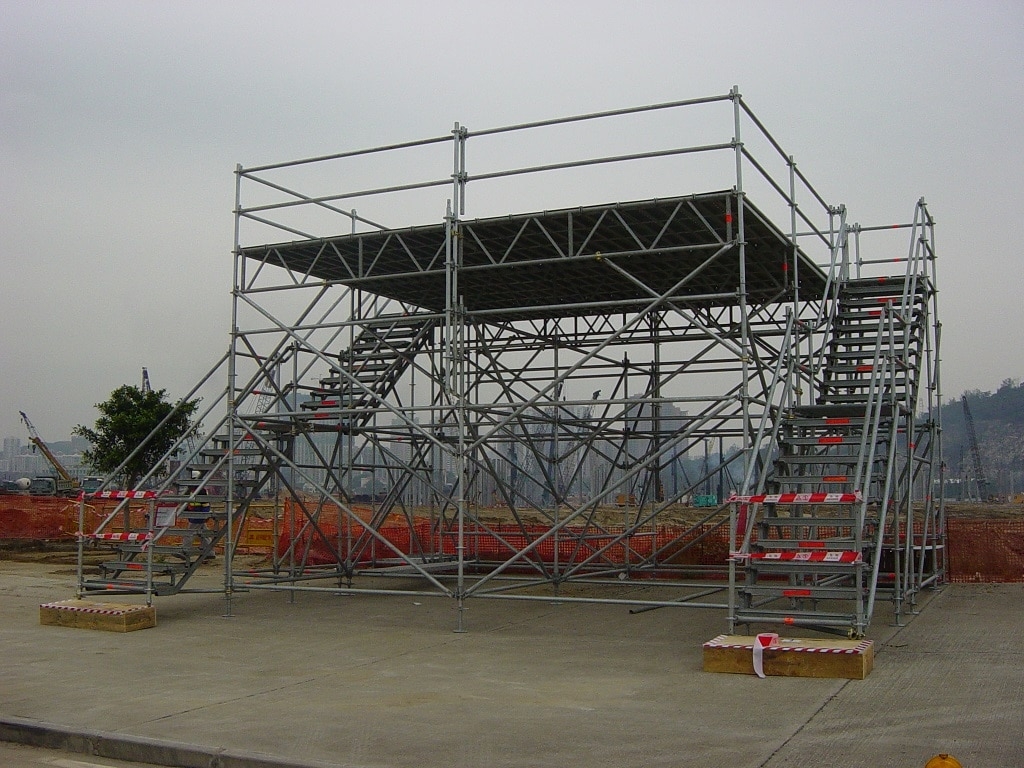Safe and Durable Scaffolding Guildford for Your Upcoming Construction Work
Safe and Durable Scaffolding Guildford for Your Upcoming Construction Work
Blog Article
A Comprehensive Guide to the Necessary Attributes of Scaffolding in Modern Construction
The landscape of contemporary building significantly relies upon efficient scaffolding systems that focus on efficiency, safety and security, and technology. As projects expand in intricacy, recognizing the crucial functions of scaffolding comes to be vital for guaranteeing employee security and optimizing job timelines. This overview explores different kinds of scaffolding, highlights key safety and security attributes, and analyzes material innovations that contribute to performance and sustainability. However, the effects of these components extend far past mere building and construction practices, triggering a closer take a look at just how they affect general project success and worker health.
Types of Scaffolding
Although scaffolding systems can vary commonly in design and application, they usually fall into a number of distinct classifications that deal with different building demands - Scaffolding. The most common kinds consist of supported scaffolding, suspended scaffolding, and rolling scaffolding
Sustained scaffolding contains systems sustained by a structure of posts, which provide a raised and steady working surface. This kind is normally utilized for jobs that need considerable elevation, such as bricklaying or external painting.
Suspended scaffolding, alternatively, is used for jobs needing access to high elevations, such as cleansing or repairing structure facades. This system hangs from a roof or another structure, allowing employees to reduced or increase the system as needed.
Rolling scaffolding attributes wheels that permit simple flexibility throughout a work website. It is especially useful for jobs that call for frequent moving, such as indoor operate in large rooms.
Each sort of scaffolding is made with particular applications in mind, making sure that construction tasks can be brought out successfully and efficiently. Understanding these categories is vital for choosing the suitable scaffolding system to fulfill both task demands and site problems.
Key Safety And Security Functions
Safety is paramount in scaffolding systems, as the prospective threats connected with operating at heights can lead to severe mishaps if not appropriately managed. Secret safety attributes are essential to guarantee the well-being of employees and the stability of the construction website.
Most importantly, guardrails are important. These obstacles provide a physical guard versus drops, dramatically minimizing the danger of serious injuries. Additionally, toe boards are usually utilized to stop devices and materials from diminishing the scaffold, securing employees listed below.
One more vital component is using non-slip surfaces on platforms. This function boosts grip, especially in negative weather conditions, thus minimizing the chance of slips and drops. Gain access to ladders should be safely placed to promote safe access and leave from the scaffold.
Regular assessments and upkeep of scaffolding systems are additionally essential. These inspections guarantee that all parts are in great condition and working appropriately, addressing any kind of wear or damages promptly.
Finally, proper training for all workers involved in scaffolding operations is essential to ensure that they comprehend security protocols and can recognize possible risks. Scaffolding. Jointly, these features create a safer working setting and considerably minimize threats linked with scaffolding
Product Advancements
Innovations in product scientific research have actually significantly influenced the scaffolding industry, enhancing both security and performance in modern building and construction. The intro of high-strength steel and light weight aluminum alloys has actually changed typical scaffolding systems. These products are not only lighter, making them much easier to assemble and carry, but additionally give exceptional load-bearing abilities. This results in scaffolding structures that can support greater weights while lessening the risk of collapse.
Additionally, innovative composite products, such as fiberglass-reinforced plastics, have arised as practical options. These materials are resistant to rust and ecological deterioration, therefore prolonging the life expectancy of scaffolding systems, especially in severe weather. The usage of such materials contributes to lower upkeep costs and ensures constant performance with time.


Style Considerations
Thinking about the complexities of contemporary construction tasks, efficient scaffolding style is paramount to making certain both functionality and safety. Layout factors to consider need to include numerous elements, consisting of tons ability, elevation, and the certain needs of the building website. Each task presents special challenges, requiring a versatile method to scaffolding systems that can adapt to differing problems.
Architectural honesty is crucial; consequently, designers need like it to determine the lots that the scaffolding will support, consisting of workers, materials, and devices. The selection of products plays an essential function in making certain the scaffolding can hold up against these tons while remaining resilient and lightweight. In addition, the design Scaffold Service needs to permit easy gain access to and egress, promoting the smooth movement of employees and products.
Safety and security functions, such as guardrails and non-slip surfaces, ought to be included to reduce risks of accidents. The format has to consider the surrounding setting, including surrounding structures and possible risks. By addressing these design considerations, construction companies can enhance the performance of scaffolding systems and advertise a more secure working environment, ultimately adding to the general success of the task.
Upkeep and Examinations
The efficiency of scaffolding systems expands beyond preliminary layout and execution; continuous maintenance and normal assessments are crucial to ensuring their continued performance and security throughout the duration of a project. Regular examinations should be performed by certified personnel to identify any kind of indications of wear, damage, or instability that can compromise the stability of the scaffolding.
Upkeep methods should consist of regular checks of architectural parts, such as slabs, installations, and frames, making sure that all components remain secure and totally free from deterioration or other wear and tear. Additionally, the performance of security functions, such as guardrails and toe boards, have to be assessed to guarantee compliance with safety guidelines.
Documentation of all evaluations and upkeep tasks is crucial for accountability and regulative compliance. A systematic method to record-keeping not just help in tracking the condition of the scaffolding but also gives essential evidence in case of an event.
Eventually, developing a comprehensive upkeep and examination routine will substantially decrease the risk of crashes and boost the general safety and security of the construction website. By prioritizing these practices, building and construction supervisors can protect workers and promote the job's stability.

Conclusion
In verdict, the vital features of scaffolding in modern-day building encompass an array of vital components, including varied types, essential safety devices, product advancements, and thoughtful style considerations. Highlighting security with guardrails and non-slip surface areas, along his explanation with innovations in materials like high-strength steel, enhances both performance and sustainability. In addition, normal maintenance and assessments are important for making certain architectural honesty and security on construction websites, eventually promoting reliable job execution and promoting the well-being of workers.
The landscape of contemporary construction significantly depends on reliable scaffolding systems that prioritize efficiency, security, and technology.Innovations in material scientific research have actually considerably influenced the scaffolding industry, boosting both security and performance in modern construction. Generally, these product developments not only boost the efficiency and security of scaffolding systems but additionally straighten with the industry's press in the direction of sustainability, as numerous contemporary materials are made to be a lot more environmentally friendly.
Taking into consideration the intricacies of modern-day building jobs, efficient scaffolding layout is paramount to making sure both performance and safety.In verdict, the important attributes of scaffolding in modern-day building and construction include a variety of critical components, including diverse types, crucial safety systems, material technologies, and thoughtful layout considerations.
Report this page